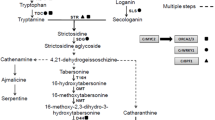Abstract
Plants of Eichhornia crassipes grown at various levels of cadmium ranging from 0.1 to 100 μg ml−1 accumulated Cd in a concentration and duration dependent manner. At all levels, Cd accumulation by various plant tissues followed the order roots shoot leaves. Approximately 80% of total Cd was accumulated by plant at highest concentration (100 μg ml−1) used in the experiment. Cadmium induced phytotoxicity appears at 25.0 μg ml−1 resulting into reduced levels of chlorophyll, protein and in vivo nitrate reductase activity of the plant. However, a slight induction of these physiological variables was obtained at lowest Cd (0.1 μg ml−1) concentration. In contrast, carotenoid content increased at highest Cd concentration i.e., 100 μg ml−1. Similar effects at low and high levels of Cd was obtained with respect to mitotic index and micronuclei in root meristem of the plant. It could be inferred that Cd toxicity in plant is differential depending upon the low and high concentration of Cd in the medium.
Similar content being viewed by others
References
Arnon, D. I. (1949). Copper enzymes in violated chloroplast polyphenol oxidase in Beta vulgaris. Plant Physiology, 24, 1–15.
Das, S., & Jana, B. B. (1999). Dose-dependent uptake and Eichhornia-induced elimination of cadmium in various organs of the freshwater mussel, Lamellidens marginalis (Linn.). Ecological Engineering, 12, 207–229.
Delgado, M., Bigeriego, M., & Guardiola, E. (1993). Uptake of Zn, Cr and Cd by water hyacinths. Water Research, 27, 269.
Environmental Protection Agency (1975). Test methods for assessing the effect of chemical son plants. Recommended test protocols: approach for evaluation of toxicity to aquatic vascular plants. In R. Rubinstein & J. Smith (Eds.), EPA 560-17-7-5-008, final report (pp. 3-117–3-120). Washington, District of Columbia: US Environmental Protection Agency.
Francis, E. C., Ralph, W. S., & Fred, L. S. (1982). Uptake of arsenic, cadmium, lead and mercury from polluted waters by the water hyacinth Eichhornia crassipes. Environmental Pollution, 27, 31–36.
Gomez, K. A., & Gomez, A. A. (1984). Statistical procedures for agricultural research. New York: Wiley.
Gonzalez, H., Martin, L., & Mirta, O. (1989). Water hyacinth as indicator of heavy metal pollution in the tropics. Bulletin of Environmental Contamination and Toxicology, 43, 910–914.
Jamil, K., Madhavendra, S. S., Jamil, M. Z., & Rao, P. V. R. (1987). Studies on water hyacinth as a biological filter for treating contaminants from agricultural wastes and industrial effluents. Journal of Environmental Science and Health, B22, 103–112.
Kenneth, E., Pallett, K. E., & Young, A. J. (2000). Carotenoids. Antioxidants in higher plants. In Ruth G. Alscher & John L. Hess (Eds.), (pp. 60–81). CRC Press.
Krishnamurti, C. R., & Vishwanathan, P. (1991). Cadmium in the Indian environment and its human health implications. In C. R. Krishnamurti & P. Vishwanathan (Eds.), Toxic metals in the Indian environment (pp. 75–95). New Delhi: McGraw-Hill.
Lowry, O. H., Rasebraugh, N. J., Farr, A. L., & Randall, R. J. (1951). Protein measurement with folin-phenol reagent. Journal of Biological Chemistry, 193, 265–275.
Maria, A. M., Maria, V. D., & Noemi, L. S. (2001). Cadmium uptake by floating macrophytes. Water Research, 35(11), 2629–2634.
Mazen, A. M. A., & El Maghraby, O. M. O. (1997). Accumulation of cadmium, lead and strontium, and a role of calcium oxalate in water hyacinth tolerance. Biologia Plantarum, 40(3), 411–417.
Muramoto, S., & Oki, Y. (1983). Removal of some heavy metals from polluted water by water hyacinth (Eichhornia crassipes). Bulletin of Environmental Contamination and Toxicology, 30, 170–177.
Nriagu, J. O., & Pachyan, J. M. (1988). Quantitative assessment of worldwide contamination of air water and soil by trace metals. Nature, 333, 134–139.
Panda, B. B., Das, B. L., Lenka, M., & Panda, K. K. (1988). Water hyacinth (Eichhornia crassipes) to biomonitor genotoxicity of low levels of mercury in aquatic environment. Mutation Research, 206, 275–279.
Panda, K. K., Lenka, M., & Panda, B. B. (1989). Allium micronucleus (MNC) assay to assess bioavailability, bioconcentration and genotoxicity of mercury from solid waste deposits of a chloralkali plant, and antagonism of L. cysteine. Science of the Total Environment, 79, 25–36.
Price, N. M., & Morel, F. M. M. (1990). Cd and cobalt substitution for zinc in a marine diatom. Nature, 344, 658–660.
Rai, U. N., Gupta, M., Tripathi, R. D., & Chandra, P. (1998). Cadmium regulated nitrate reductase activity in Hydrilla verticillata (l.f.) Royle. Water, Air and Soil Pollution, 106, 171–177.
Rai, U. N., Sinha, S., Tripathi, R. D., & Chandra, P. (1995). Wastewater treatability potential of some aquatic macrophytes: removal of heavy metals. Ecological Engineering, 157, 1–8.
Rai, U. N., Tripathi, R. D., Sinha, S., & Chandra, P. (1995). Chromium and cadmium bioaccumulation and toxicity in Hydrilla verticillata (l.f.) Royle and Chara corallina Wildenow. Journal of Environmental Science and Health, A30(3), 537–551.
Rosas, I., Carbajal, M. E., Gomez-Arroyo, S., Belmont, R., & Villalobos-Pietrini, R. (1984). Cytogenetic effect of cadmium accumulation on water hyacinth (Eichhornia crassipes). Environmental Research, 33, 386–395.
Snell, F. D., & Snell, C. T. (1949). In colorimetric methods of analysis, Vol. II (pp. 785) 3rd edn. Princeton: Van Nostrand.
Srivastava, H. S. (1974). In vivo activity of nitrate reductase in maize seedlings. Indian Journal of Biochemistry & Biophysics, 11, 230–232.
Stobart, A. K., Griffiths, W. T., Ameen-Bukhari, I., & Sperwood, R. P. (1985). The effect of Cd2+ on the biosynthesis of chlorophyll in leaves of barley. Physiologia Plantarum, 63, 293–298.
Author information
Authors and Affiliations
Corresponding author
Rights and permissions
About this article
Cite this article
Mishra, K.K., Rai, U.N. & Prakash, O. Bioconcentration and Phytotoxicity of Cd in Eichhornia crassipes . Environ Monit Assess 130, 237–243 (2007). https://doi.org/10.1007/s10661-006-9392-5
Received:
Accepted:
Published:
Issue Date:
DOI: https://doi.org/10.1007/s10661-006-9392-5




